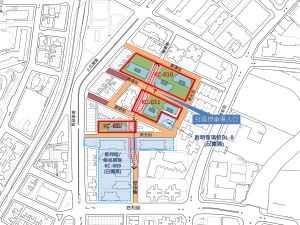District-based Renewal - People-oriented and keeping abreast of the times
|
Urban renewal is never just about replacing old buildings by new ones. In accordance with the Urban Renewal Strategy updated in 2011, a comprehensive and holistic approach focusing on four areas, namely redevelopment, rehabilitation, revitalisation and heritage preservation, is adopted to regenerate our urban areas. We strive to solve the problems of rapidly-ageing buildings in Hong Kong, improve urban living environment and rejuvenate old areas based on the actual circumstances of different cases, such as building conditions and owners’ preference on initiating building rehabilitation, in order to uphold the vision of "redeveloping and rehabilitating where appropriate”. The Urban Renewal Authority (URA) has recently announced a number of redevelopment projects in To Kwa Wan in a district-based approach after summarising the past experiences, and having considered the community’s aspirations of maintaining the urban fabric and unique characteristics of the different districts in recent years. The projects are a new attempt to keep abreast of the times with a view to striking a balance between improving the residents’ living environment, recreating district characteristics, as well as enhancing the planning benefits and redevelopment efficiency. Past experience has revealed that there are both advantages and disadvantages for redevelopment projects at different scales. The re-zoning of large-scale comprehensive redevelopment areas can bring about the much needed new residential, commercial, transport and open space facilities for local residents, and improve the environment of the old community in a holistic manner. However, as extensive site areas are involved and more residents and businesses are affected, a longer lead time is needed for this redevelopment model. For instance, the Kwun Tong Town Centre redevelopment project, occupying a site area of five hectares, has been expected to take more than two decades to complete since its announcement. On the contrary, although the living conditions of single-block old buildings can be improved earlier by way of redevelopment, the social benefit to the community as a whole is rather limited. Moreover, the redevelopment project of each of these individual single-block buildings has to comply with the existing legislations and requirements in respect of supporting facilities such as the provision of separate carparks, transformer rooms and refuse collection points, which are often converted from the original street-front shops. Therefore, it will become rather difficult to preserve the existing community ambience. In the light of this, the URA has adopted a district-based approach in the redevelopment of Kowloon City as a means to strike a balance among the aforementioned considerations. Suggestions raised at the Kowloon City District Urban Renewal Forum in 2014, including the priority for renewal of several sub-areas within the district, were also taken in account. Take the URA’s recent renewal projects at Eight “Wan” Streets, Kai Ming Street and Ngan Hon Street as examples. Many narrow alleys are located in the district. A number of these alleys are dead-end roads and always occupied by illegally parked vehicles, creating nuisance to other cars and pedestrians, and posing environmental hygiene problems. However, to preserve the original street-front ambience of these sub-areas, the URA plans to divide the site into a few plots for renewal rather than building a mega shopping mall. The alleys will be transformed into car-free zones for better pedestrian flow while conserving the characteristics of domestic shops on streets and enhancing vitality. Furthermore, the project involves extending Wan On Street, which was once a dead-end road, to the main roads to enhance connectivity. Linking adjoining small sites on Kai Ming Street and Ngan Hon Street, and planning their uses based on the district-based approach can also create synergy and bring greater benefits to the community. For example, the URA plans to centralise parking spaces in one of the larger sites to avoid provision of separate carparks in individual sites. Since the original ground-floor shops of the sites need not be occupied as ingress/egress of the car parks, local ambience and characteristics of the community can be better preserved. Meanwhile, the district-based approach can enable better flexibility and connectivity for street designing work, and hence improving the district’s traffic network and volume. Public response to the URA’s district-based approach has been generally positive so far. Urban renewal work has always been challenging. Upholding the people-oriented spirit and keeping abreast of the times, the Development Bureau and the URA are committed to improving the living environment of residents in old districts and meeting different public needs as far as practicable. In the past year, the URA Board and our colleagues rose above all difficulties and served the public with undaunted dedication and professionalism. I would like to express my heartfelt gratitude to them. |
|
12 June, 2016
Back